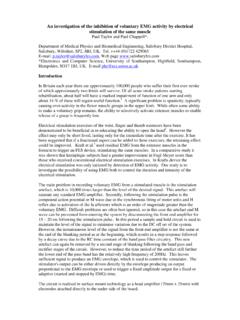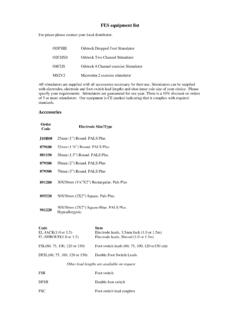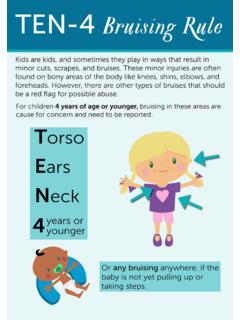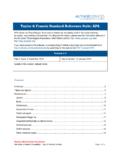Transcription of Upper limb electrical stimulation exercises. P Taylor, G ...
1 Salisbury FES Newsletter Jan 20021 Upper limb electrical stimulation taylor , G Mann, C Johnson, L MaloneIn this article we wish to document some of the electrical stimulation techniques we use for the Upper limb ,primarily with hemiplegics, in the Salisbury FES clinic. There is a growing body evidence for theeffectiveness of the use of electrical stimulation in the Upper limb but it is not the intention that it is reviewedhere. Instead, we refer you to the excellent recent review articles by John Chae et. al1, 2 and thecomprehensive review in the Rancho The Rancho Book also includes a very useful description ofelectrical stimulation techniques and treatment stimulation can be used for the following purposes: For strengthening weak muscleAs with any repetitive exercise , muscle bulk and strength will be increased. This will also lead to greatercapillary density and therefore improved local blood supply and tissue condition. For increasing ROME lectrical stimulation can provide regular stretching, similar to passive stretching but performed over amore extended period.
2 Be careful that some joints are not over stretched while trying to increase therange of others. For example it is sometimes useful to use MCP joint extension blocking splint to protectthe MCP joints and improve the effectiveness of the action on the PIP and DIP joints. Another examplemight be the use of wrist flexion blocking splints when exercising finger flexors. Care must be takenthat repetitive movement does not lead to skin marking. For enhancing the effect of botulinum can be done in two ways. Firstly, it has been shown that botulinum toxin is more easily taken up bythe receptors if the muscle is active. This can be achieved by direct stimulation of the target muscle orby exercise of the antagonist muscle leading to stretch reflexes in the target muscle. Botulinum take upoccurs over the first two days following injection. The second method is to use electrical stimulation toenhance relearning of movement in the three month window before spastic tone returns.
3 For relaxation of spastic musclesWhen a muscle contracts, activity in the muscle spindles is relayed via inhibitory interneurones to the amotor neurones of the antagonist muscle reducing its activity. This is known as reciprocal inhibition andits effect can be exploited by stimulating the antagonist muscle to the spastic muscle. As the Ia afferents,the nerves that pass from the muscle spindles to the spinal cord and inhibitory interneurones, are of largediameter, they require only a low level of stimulation to excite them so will always be excited even if thestimulation produces only a small contraction. Consequently stimulation will have a direct effect as wellas via mechanical changes of tension in the muscle itself. Commonly, after exercising the antagonists tothe spastic muscles there is a period of reduced spasticity which can last from minutes to hours. Byrepetition of these exercises the synaptic connections can be strengthened via long term potentiation andspasticity reduced for an extended time.
4 However, most studies have shown that the treatment needs tobe maintained long term for continuing therapeutic of the spastic muscles themselves have also been shown to have a relaxing effect. This isthought to be due to antidromic stimulation of the a motor neurones, that is stimulation that course anerve impulse to travel up the nerve towards the spinal cord, acting upon Renshaw interneurones. TheRenshaw interneurones has an inhibitory effect on the a motor neurones, reducing its excitability andtherefore reducing the spastic activity. Reciprocal stimulation of agonist and antagonist pairs can be aneffective way of reducing spasticity. However, there are some concerns that by strengthening spasticmuscles, spasticity may be stronger when it returns. Generally, we restrict stimulation to the antagonistmuscles unless strengthening and retraining of the spastic muscle is also a clinical FES Newsletter Jan 20022 For re-education of movementWhen a muscle contraction is produced by electrical stimulation , a whole range of sensory inputs areproduced.
5 This includes the direct sensation from the stimulation and the proporeceptive feedback fromjoints, tendons, muscles and mechanoreceptors. There will also be antidromic stimulation of a and gmotor neurones. All this will cause a significant increase in activity along the remaining pathways to thecortex and other centres, stimulating the production of new synaptic connections. Excitation of the Iaafferents will have the same effect as activating muscle spindles by stretching them, causing excitation ofthe a motor neurone to cause a muscle contraction. However, this increased level of a motor neuroneexcitation will also make it easier for weak descending inputs to activate the motor neurone and thereforeproduce a voluntary contraction. It is good practice to ask the patient to try and assist the action of thestimulator with voluntary movement to enhance this effect. However, this voluntary effort must not beso great that it cause a rise in spasticity and inhibits the desired movement.
6 To improve sensory awarenessAs described above, the sensory input will encourage new synaptic connections in the sensory cortex andincrease sensory awareness. Many anecdotal comments have been reported of improved sensory abilityand this has been illustrated by improvements in 2 point discrimination and reduction of neglectsyndrome. To reduce pain associated with spasticity or shoulder reducing spasticity and improving the resting position of joints, pain can be reduces or stimulation itself will also have an effect similar to TENS, as the stimulation waveforms are similarchiefly differing in only be effective the exercises should be performed on a regular basis, ideally daily or twice daily. As ours isan outpatient clinic, patients take stimulators home. exercise times commence for only 5 minutes sessions ata time, increasing to up to 30 hour over a period of one month. Regular follow up is required to ensure theexercises are performed correctly.
7 It is not uncommon that electrode positions will need adjusting as patientsprogress or simply because they have forgotten the correct positions. For this reason, patient and carereducation is very important. We supply written instructions, electrode position diagrams or digitalphotographs and we mark electrode positions with indelible marker pens. To assess their progress we usethe Jebsen- taylor hand function test or the Action Research Arm Function Test. We also record active andpassive ROM, Ashworth and 2 point spasticity is present it is important that a stimulator with a long rising ramp of at least 2 seconds isused. This is because a sudden contraction will rapidly stretch the antagonist muscle and induce a stretchreflex resulting in a reduced ROM. A long ramp will also be more comfortable which in its self may reducetone levels. We have not found that the stimulation frequency is very critical in practice but generally 40 Hzproduces a smooth and comfortable contraction.
8 All exercises are performed using cyclical stimulation withstimulation on times of 8 10 seconds followed by a rest period of the same time (Microstim modes 6 or 7).A standard pulse width of 300ms is fine but it is sometimes useful if using the Odstock 4 Channel ExerciseStimulator to reduce the pulse width to 100ms as this allows finer control of the amplitude is our impression that patients have a greater re-education effect if they have some motor ability beforetreatment begins. As a minimum, it should be possible to take the hand to the mouth. Patients with lessability than this may still benefit from use of stimulation to reduce spasticity for cosmesis, pain reduction orassistance ADL tasks such as dressing. As a general rule, the number of muscle groups exercised should bekept to a minimum. Most patients will find more than 2 muscle groups hard to cope with. Less able patientswill need assistance from a carer to perform the exercises. Cardiac demand pace makers are is because interference from the stimulator may prevent the detection of bradycardia.
9 Poorly controlledepilepsy should also be avoided, as there are some anecdotal incidents of increased symptoms when usingelectrical stimulation . However, where it is controlled by drugs there should be no FES Newsletter Jan 20023 Upper limb FES applications in hemiplegiaShoulder subluxationSubluxation occurs when muscle tone around the shoulder is reduced, resulting in a loss of continuity at thegleniol-humeral joint. Tissues around the socket become stretched and pain is frequently a problem as wellas reduced function. Often, when spasticity follows a period of flaccid paralysis, muscle tone will not bebalanced and over active pectoral muscles can pull the humerus into internal rotation. The muscles aroundthe shoulder can be divided in to two groups, those such as the supraspinatus or teres minor which principalrole is to locate the humerus head in the socket and those such as the deltoid or pectorals, which primarilymove the whole limb . The deltoid is easy to stimulate as it is the most superficial muscle but it is useful totarget supraspinatus because of its central role in locating the numeral head.
10 If there is no internal rotation,place one electrode over middle deltoid and the second over supraspinatus. Chose which electrode to makethe active by which you wish to have the strongest effect. For example if placing the active over the deltoidproduces too much abduction, reveres the the arm is internally rotated, place the deltoid electrode over the posterior deltoid. If greater externalrotation is required, stimulation of the teres minor and infraspinatus can be tried. stimulation of thesupraspinatus can be difficult to achieve without activation of the trapezius resulting in elevation of theshoulder girdle. If this is the case it is often better to stimulate the middle and posterior deltoid. Twochannels of stimulation can be used, alternating between the electrode StabilisationScapula winging is a common problem following hemiplegia and is due to weakness in muscle such as thetrapezius and rhomboids. These muscles can be exercised using electrical stimulation with the electrodepositions shown.










